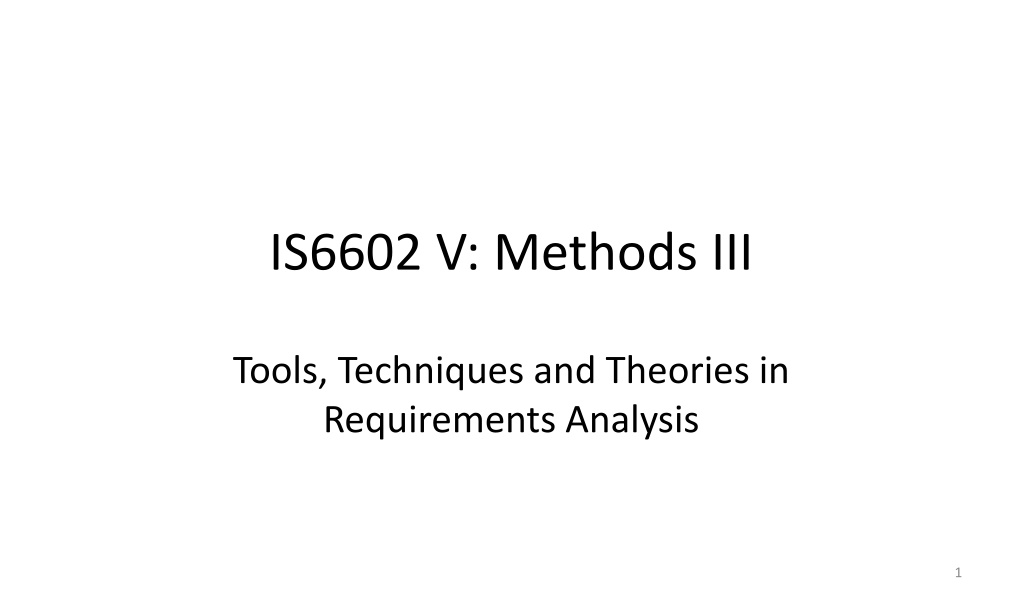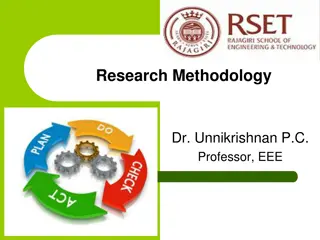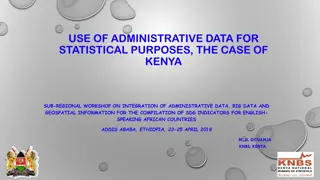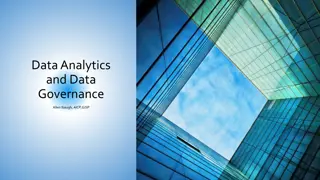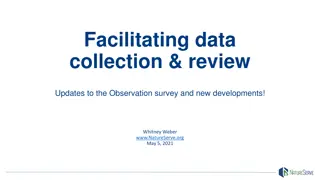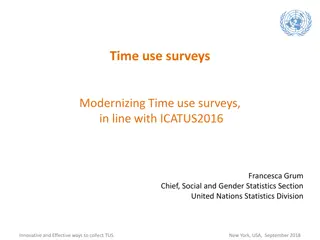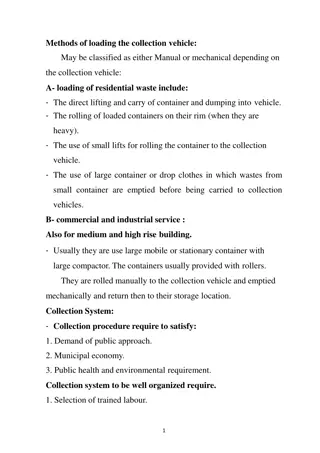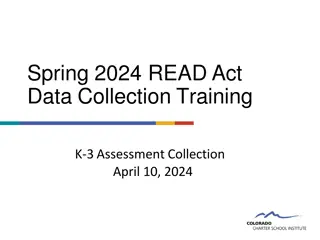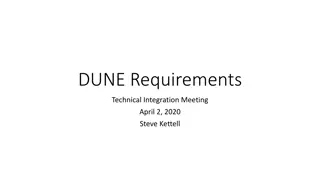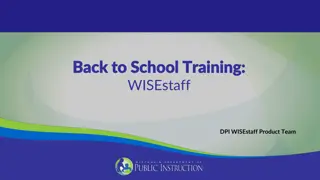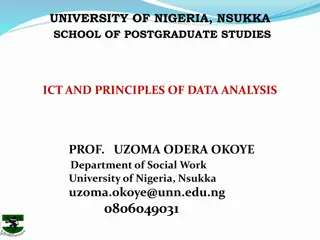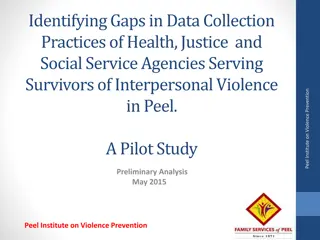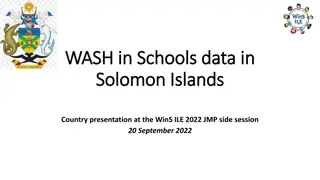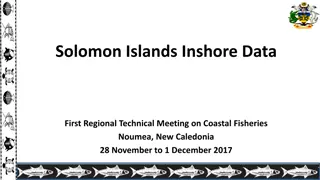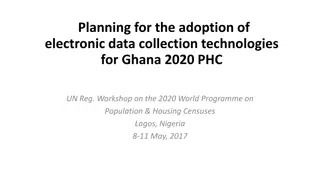Effective Data Collection Strategies for Requirements Analysis
In the process of requirements analysis, obtaining accurate and valuable data is crucial. The key is to ask targeted and open-ended questions, ensuring responses are detailed and insightful. It's important to test questions for clarity and neutrality, and to gather input from a representative sample of stakeholders. This approach leads to a comprehensive understanding of the problem at hand, enabling effective action planning.
Download Presentation

Please find below an Image/Link to download the presentation.
The content on the website is provided AS IS for your information and personal use only. It may not be sold, licensed, or shared on other websites without obtaining consent from the author. Download presentation by click this link. If you encounter any issues during the download, it is possible that the publisher has removed the file from their server.
E N D
Presentation Transcript
IS6602 V: Methods III Tools, Techniques and Theories in Requirements Analysis 1
The Green Light Once you have an agreement with the client on how to proceed, you can start to collect data in order to determine the exact requirements This phase will lead towards action planning Now is the time to decide which questions to ask and how to ask them You want to get answers that are useful, understandable and comparable 2
For Example Lets assume that we want to find out if the employees are satisfied with their current IT Which IT are we talking about? Corporate system? How do they use it? Who uses it? Who misuses it? In what ways is this IT adequate or not? Ask for examples that illustrate effective or ineffective usage. What kind of functionality is not available now that the employees would like? Why? Do the employees like the current IT? Why? Does it meet their needs? Does it support the right functions? Who does the current IT serve best, and why? 3
Continued Does the adequacy of the IT refer to: Speed? Accessibility? Ease of use? Usefulness? Functionality? The questions we ask should NOT have Yes/No answers: this is useless. We need (to push) employees to answer in detail 4
For Example Lets assume that you are doing a consulting project for CityU related to AIMS, as used by academic staff. Who do you want to select for the questions What questions do you think you should ask? 5
Testing Questions The exact questions we ask will depend on the context: what kind of problem or situation All questions need to be pre-tested Do people really understand them correctly? Each question should only ask about one thing Questions should be neutral and not push employees to answer in a particular way Only essential questions should be asked: people get fed up if you ask too many and then don t answer carefully 6
Representative Sampling It is important that we ask the right questions and to the right people! If we only asked managers, we would only see a narrow perspective of the problem In fact, even if the managers see a problem, perhaps no one else sees it. Getting as a broad a view of the problem as possible is essential 7
For Example You are talking to a CEO who complains bitterly that he always gets too much email. My life is continually interrupted! I need to reduce the amount of internal email in this firm. That s the real problem. When you ask exactly how many emails, the answer are not precise, it is just too many . When you ask to see the emails, the CEO becomes defensive and rejects the suggestion. You ask to talk with the employees, but the CEO is not interested; all he wants is a solution that gets the employees to send fewer emails. You need to run a seminar to provide email training to the employees. 8
The Seminar You start off the seminar by talking in general about communication patterns and the need to ensure that technology supports communication effectively The employee-participants nod their heads; it seems to make sense to them Then you ask them how many emails they a) send and b) receive each day. The answers range from 10 to 30. No one reports sending or receiving more than 30 a day, internally. 9
Analysis The numbers seem reasonable and not as dramatic as the CEO suggested, so what is happening? Are the employees lying? Is the CEO lying? Perhaps too many is not too many at all? You finish the seminar without a clear sense of having made progress 10
Afterwards You go back to the CEO to report on the seminar You explain how it went, what you talked about, how the employees reacted, and how many messages they claimed to be sending, internally The CEO looks angry and puzzled. You again ask to see his email in-box. He agrees and only asks that you not read the contents 11
Real Problems? As you look, a bunch of new emails arrives and the CEO says Look! Its like that all day You check the emails and find that most are spam, certainly not internal email. You point this out, but the CEO clearly is not interested. He wants a solution, not an explanation. You set up a spam filter to screen out most of the spam automatically. 12
Success? Perhaps this is a successful project, but it also required more time than necessary. If you had the chance to see the actual problem, not just the CEO s description of it, then the problem could have been fixed more quickly. Senior Managers may be vague about IT or KM issues For them, IS Information Systems! IS = Information Solutions. 13
Data Collection Techniques Surveys/Questionnaires Interviews Focus groups Documents Observations Narratives 14
Surveys/Questionnaires Focus on standardized question items with numerical scoring Advantages Cheaper and quicker Easy to distribute, collect and analyse data Disadvantages Must get questions right the first time cannot change later Indirect no chance to ask follow-up questions or ask for detailed explanations Cannot get detailed answers to questions 15
Survey Question Style Please indicate whether you agree/disagree with the following statements: AIMS is useful AIMS helps me to complete my work satisfactorily AIMS has a badly designed interface AIMS is complicated to use I do not trust AIMS What are the problems with these kinds of questions? 16
Interviews Focus on individual respondents with complex questions that can be extended Advantages Questions can be modified as needed; detailed answers are possible Follow up questions enable in-depth probing, with why and how questions Disadvantages Requires careful training; need interviewers to be consistent and focused on the real problem Takes more time per respondent to collect, transcribe and analyse data Qualitative analysis requires more care to ensure that there is empirical support for findings 17
For Example Please can you describe your experience using AIMS? What do you think are the strongest aspects of AIMS? How could the AIMS interface be designed in a more user- friendly way? What additional functions should be added to AIMS and why would these be valuable? Do you create short-cuts to make your use of AIMS easier? Do you create your own personal systems to avoid using AIMS in certain situations? Please describe them. 18
Compare The survey questions and the interview questions And think about the value that you can get through each style of asking questions. Which style do you think you would prefer to use and why? What skills would you need to develop so as to use that style effectively? 19
My Interview Style I usually interview people with an assistant Breaking the ice is important Interviewees often have rich experiences to draw on I try to push them to talk more, to tell the story, to provide details I don t tell them what others said (confidentiality) I want to learn their experience 20
Focus Groups Usually small (5-10 members) groups of people who are purposefully selected on the basis of their Language, Skills, Seniority, Age, Education Require a detailed protocol Which questions are going to be asked? Sequence? Why are these the right questions? Require a confident facilitator The facilitator has to keep the group focused and manage the difficult/different personalities Trust needs to be established if people are to participate comfortably 21
Focus Groups Advantages More efficient to talk to several people at once Can be computer-mediated with software support Can stimulate group interactions with a diversity of opinions; good if there are different perspectives Disadvantages More senior people may dominate; juniors silent Hard to facilitate effectively and keep on track Data needs to be recorded, transcribed and analysed 22
Software Support Some groupware applications may support online focus group discussions and brainstorming G Suite (gsuite.google.com) has similar functionality Social media chat applications can be adapted to this purpose This enables multiple people to share at the same time This is more effective and efficient People do not need to be in the same room Shy participants can type their ideas without fear of interruption or others disagreeing; everyone gets a chance to participate The meeting can extend over days or weeks, so people can join when they are free Human facilitation is still essential to keep the conversation on track 23
Documents Focus: Corporate documents Many organisations publish documents for internal and external use that can reveal interesting information May be paper- or web- based May describe internal or external situations Brochures, reports, advertising, PR, 24
Observations Consultants can visit employees at work and observe how they engage in work processes, which technologies they use, which problems they encounter and how they overcome them Observations can be combined with informal interviews, as employees explain how they work in their normal workplace What else could consultants learn when they visit employees in their own workplace? 25
Personal Experiences I find that observations are under rated We can see a lot if we want to We need to record it, with a camera or paper We can observe the general office layout We can also observe people at work This may lead to unexpected revelations and unanticipated findings that inform later interviews Eastwei, Velox, ThoughtWorks Never give up the opportunity to visit an office or work location! 26
Narratives Narratives involve the telling of stories Stories are a powerful communication device that are often used in corporate life Employees can be encouraged to write or tell stories that capture their experiences in detail Narratives are less formal and less structured than interviews, but also allow more detailed descriptions Narratives can be shared (group) 27
Tools for Situation and Requirements Analysis There are many tools that can be applied to an analysis of organizational problem situations Many of these involve some form of modelling Examples include: Balanced Scorecard (BSC) Business Process Modelling (BPM) Value Chain Analysis (VCA) Work Systems Analysis (WSA) Five Forces Model; SWOT Analysis; etc. 28
BSC The Balanced Scorecard is a tool to measure in detail the current working practices in an organisation as well as to plan for change A BSc has four perspectives Financial Customer Internal Process Future Readiness 29
Perspectives & Relationships in the Balanced Scorecard Financial Perspective Are we meeting the expectations of shareholders? Internal Process Perspective Are we doing the right things? Are we doing things right? Customer Perspective Are we delighting (or at least satisfying) our customers? Future Readiness Perspective Are we prepared for the future? 30 Adapted from Kaplan & Norton (1992)
BSC The consultant may find the Internal Process and Future Readiness perspectives to be particularly valuable Internal Process: Are we doing the right things in the right way? Future Readiness: Are we ready for emerging technologies and practices 31
BSC In a BSC, it is conventional to identify: Objectives: what do you want to achieve? Initiatives: what actions will you take to achieve the objective? Measures: how will you measure the achievement? Targets: what is the achievement level? Consultants could use a BSC approach as a way of helping employees to think about the current working arrangements and ways in which they can be improved 32
BSC for the IS Support Unit of a Global Shipping Firm Perspectives Objectives Initiatives Measures Targets Business Value Increase profit Do more with less! $ 10% CAGR User Delighted users Involve users in systems design procedures User 95% satisfied by 2024; 99% by 2026 satisfaction index Internal Process Excellent service performance Skilled IT staff Tight time control in all projects Focused training budget Service delivery on time 99% on time by 2024? Future Readiness Prof & Acad Quals 100% with MSc by 2024; 75% with PhD by 2026 33
BPM Business Process Modelling is a useful tool to map out all the different activities that are undertaken by employees BPM is often done by Business Analysts and Subject- Matter Experts Analysing BPMs can lead to better process effectiveness and efficiency You may be particularly interested in how IT-related activities contribute to process flow 34
Imagine that you need to help CityUs ESU To do a requirements analysis of AIMS! Some users (staff/students) don t like it; it needs improving Can you use any of the tools and techniques discussed in today s class, e.g. the BSC, BPM, SWOT, etc. to help? Focus on the internal process and future readiness perspective What are the current functions of AIMS? How could they be enhanced? What is not good? Who do you need to talk to? Questions? What future developments in AIMS can be imagined? Consider the points of view carefully 36
Work Systems Work System Theory (WST) (Alter, 2013) provides a framework that can be used to describe how is work done in organisations WST can be used by consultants as an instrumental theory to summarise findings and guide analysis WST provides a common language to enable conversations among the consultants and stakeholders WST can help consultants to demonstrate their understanding of the current situation in the organization, and thereby facilitate trust building 37
WST 38
WST Components 1 What is the purpose of the system that you are describing? Who are the Customers of the system? What are the Products and Services created by the system? Who are the Participants in the system? What Information & Knowledge is used in the system? 39
WST Components 2 What are the technologies used in the system? What about the operating environment, including any legal restrictions, the competition and the social environment What about the organisational infrastructure including cultural norms and local practices What about the organisational strategy that governs how this system works? 40
Summary In order to develop a clear understanding of a problem, we need to investigate it in detail We cannot trust one person to tell us the whole story Different tools may reveal different parts of the story As we try to develop a holistic understanding A better understanding should lead to a better solution We will look at Work Systems in more detail next week 41
